Natural gas production is getting a big boost in Canada thanks to the fast-tracking of Phase 2 of the LNG Canada project. Motley Fool Canada Chief Investment Officer Iain Butler shares two investing strategies to benefit from the news, along with a handful of dividend stocks.
Prefer to read? There’s a transcript below.
Transcript
Nick Sciple: I’m Motley Fool Canada Senior Analyst Nick Sciple, and this is the 5-Minute Major, here to make you a smarter investor in about 5 minutes. Last week, Canada’s Prime Minister Mark Carney announced a list of projects deemed in the national interest that the country intends to fast-track to approval within the next two years. One of those projects is Phase 2 of the LNG Canada project in British Columbia, and that Phase 2 would plan to double Canada’s liquefied natural gas export capacity. Today, we’ll discuss what that expansion could mean for Canada’s natural gas market and share a few companies that could benefit. My guest today is Motley Fool Canada Chief Investment Officer Iain Butler. Iain, thanks for joining me.
Iain Butler: Great to be here, Nick. Lots of moving and shaking in the Canadian economy, thanks to big government injections here.
Nick: Yeah, we’re just a few months on from wrapping up Phase 1 of this LNG Canada project, a $40 billion project that sent out its first liquefied natural gas export shipment back in June. Now the country already looking to double that capacity as soon as possible. At least the government can get in the way as little as possible. What has LNG Canada meant for the Canadian natural gas market so far, and how could those trends continue if we see a further expansion of the facility?
Iain: As you say, it’s early days, and given the time it took to build Phase 1, we’re talking years here. It’s not as if the development was not unexpected by Canadian natural gas producers. Therefore, I’d say the impact on the price of the commodity natural gas has been negligible, as producers have been ramping up supply to meet these new sources of demand.
The real win, though, is market access. For forever, Canadian gas producers could really only sell to the U.S. market. That was our only outlet. And now we have a direct route to sell to buyers in Asia, who often pay a premium.
It was once described to me by a company from Malaysia that a lot of countries in Asia don’t have the resources we have, so when they flip the light switch, that energy has to come from somewhere else, so Canada is certainly going to be a key provider in the decades ahead. And so, we’ve got now a diversified customer base, we’ve created thousands of jobs, and we’ve got economic partnerships and friendly relations with the Indigenous, all go as part of these projects.
I think a lot of the same will come with Phase 2. It’s hard to predict on commodity prices, but structurally, the industry will just get bigger, and Canada is going to take an increasing part of the natural gas scene on the global stage.
Nick: Yeah, so a bigger industry with more potential export markets, more options for growth in the future. The big question is, who cashes in on that bigger market? What are some Canadian companies you think could be set to benefit?
Iain: When I think of this situation, there’s two angles to it. So on one hand, we have the aforementioned natural gas production companies. These are the companies that are extracting gas from the ground, drilling wells, and so on. So, with these expanded markets, they have the opportunity to produce more from the vast reserves that do exist. There’s significant natural gas reserves out west in Canada in the Monteney and Duvernay regions in BC and Alberta.
These reserves will be sent abroad. So, natural gas producers, again, to have in mind, all of which pay dividends. Company, Arc Resources, which is a major Motany producer, it’s already a key supplier for the Phase 1 facility.
Tourmaline Oil (TSX: TOU) is actually Canada’s largest natural gas producer. Vast reserves in the region as well. Peyto Exploration (TSX: PEY) is best known as a low-cost producer in the Canadian West, and its dividend yield is currently north of 7%, so attractive on that front. And then Canadian Natural Resources (TSX: CNR). A lot of the time, Canadian Natural Resources is lumped in with oil producers, and indeed, it’s got a significant oil sands operation.
But it’s also a major, major natural gas producer as well. So, those are for the producers.
On the other hand, the other approach would be companies that own the infrastructure that carries the gas to the coast. These are essentially pipeline companies because that gas has to get there somewhere. This is a very different business model, where the producers are reliant on the price of the commodity for their financial statements.
The infrastructure companies work more on a contract, sort of fee-for- fee-for-service, basis. So, a little more secure stream of income here.
The 2,000-pound gorilla in the industry is TC Energy (TSX:TRP), formerly TransCanada Pipeline. And that’s the company that built and operates the Coastal GasLink pipeline, and this is the primary artery that gets the gas to the coast. Phase 2 expansion would potentially require more Coastal GasLink pipeline, so an expansion project, and that could add to TC Energy’s coffers.
If we think of that as the main route, the Coastal GasLink, there’s a bunch of smaller routes that feed into that Coastal GasLink, and companies that own infrastructure that feed into it include Pembina Pipeline (TSX: PPL), which currently offers a dividend yield of 5.2%; Keyera (TSX: KEY), which offers a 4.6% dividend yield.
And another 2,000 pound gorilla, although not to the same extent, at least with regards to a pipeline to the coast, is Enbridge (TSX: ENB). And Enbridge currently yields 5.6%.
Enbridge also has a regional network out west that plays a big role in here. So, producers: relying on the commodity, but demand is shaping up well for them. They have vast reserves, so they are going to be producing gas for a long time. And infrastructure: if you want a little less volatile path to exposure on this front.
Nick: I think it’s pretty clear the Canadian natural gas market is likely to expand meaningfully as more export capacity comes online. It puts those producers in a good position as more demand for their product comes online, and additional opportunities for those pipeline businesses to drive more volumes through their network, which is, you know, opportunities for more revenue. Those are some companies to keep on your radar as this project in the national interest of Canada moves forward. Thanks for joining us for this edition of the 5-Minute Major. Hope to see you next time.






